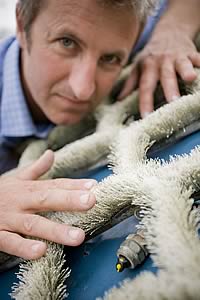07/09/07
A NOVEL spray nozzle originally designed to help farmers achieve
better weed control by treating with a sloping spray from the side,
rather than above, could also soon be helping top skiers via slopes
of a different kind.
Pictured Darryl Shailes: The sloping Hawk nozzle – already a big success for farmers – is now helping skiers on the slopes
 |
That follows testing by a Norfolk ski club where the nozzle’s
precise spray characteristics have also proved ideally suited to
wetting the surface of their dry ski slope – helping to give
skiers a smoother ride.
Developed by Syngenta Crop Protection, working in partnership with
leading nozzle manufacturer Hypro-EU, the angled nozzle was originally
conceived to help cereal growers overcome the challenge of getting
enough herbicide spray on to small black-grass weeds – when
little thicker than a paperclip in size.
By producing a 40 degree forward-angled spray, the nozzles treat
the small, upright weeds from the side where they present a bigger
target, and have been shown to deposit over twice as much spray
as a vertical nozzle, says Syngenta application specialist, Tom
Robinson.
More recently, the same nozzles alternating backwards and forwards
along the sprayer have also been shown to boost control of the
weed even earlier – using the recently-launched herbicide
Defy to treat the soil surface before black-grass has even emerged.
Now, by mounting angled Hawk nozzles upside down between the brushes
which make up a dry ski slope, the Norfolk Ski Club in Norwich
has also found them perfect for spraying a film of water to lubricate
the slope’s surface.
In this way, friction is reduced and skiers get a smoother, more
snow-like ride.
“To make the slope faster you have to irrigate it,” explains
the club’s vice chairman Nigel Riches, who also tests farm
inputs as a trials manager for the independent agricultural research
organisation, The Arable Group (TAG).
“We have been using nozzles which shoot water into the air
and so rely on wind distribution. With the Hawk nozzle coming out
at an angle, instead of spraying it in the air where it can be
blown away, it spreads it wider across the slope and puts more
on the surface. You’re getting it where you want it. The
Hawk nozzles are far more reliable,” he adds.
Club coach, Darryl Shailes, who is also chairman of the club’s
instructor’s committee, agrees that the combination of the
nozzle’s angle and finer droplets improves skiing performance.
“You get better lubrication on the brushes," explains
Mr Shailes, who also advises farmers for agronomy firm HL Hutchinson. “They
do a better job of covering the surface.
“We don’t get the dry patches, so it’s easier
to ski on, is faster and you don’t damage the skis so much.
A lot of my growers use all sorts of Syngenta nozzles,” he
adds.
According to Hypro-EU sales manager, Ian Sutton, while conventional
nozzles have been used previously on dry ski slopes, this is the
first time the company has supplied angled nozzles, as far as he
knows. However, Hawk nozzles have certainly helped farmers with
weed control, he adds.
“It’s interesting how the concept of spraying at an
angle can help in different scenarios,” continues Tom Robinson. “As
well as forward and backward angled nozzles helping with weed control – including
a 30% boost to black-grass control when used to apply pre-emergence
Defy – angled nozzles can also help when spraying potatoes.
“With Defy, we believe angled nozzles help by achieving better
spray coverage around clods on the soil surface. So perhaps a similar
thing happens when spraying brushes on the dry ski slope. Either
way, they are a very useful technology,” he adds.
 Red Diesel Victory for Farmers Red Diesel Victory for Farmers
 New Landini Tractor Dealers in Wales New Landini Tractor Dealers in Wales
 John Deere Scholarship Boosts Harper Adams Student Careers John Deere Scholarship Boosts Harper Adams Student Careers
|




